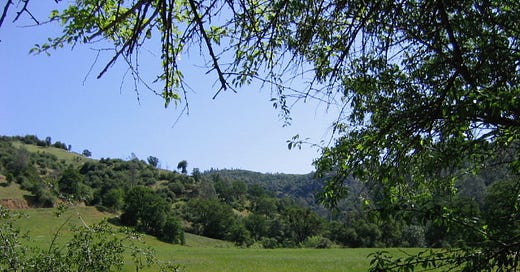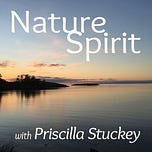Going on a spirit journey is a spiritual practice, like prayer or meditation, that can help a person navigate the challenges of life and find their place in the family of Earth. Today we ask, How is a spirit journey like other kinds of meditation? Or like other kinds of prayer? We give special attention to the process of preparing the mind and heart for a spirit journey by committing oneself to serve love, not the ego. We talk about the kinds of impressions that can arise during a journey—images, sounds, feelings, hunches—and how to learn from them after the journey ends. We also talk about how to discern which messages are coming authentically from Spirit. And of course we address the question everyone asks, especially when they're just beginning this practice: “How do I know I’m not just making stuff up?”
Transcript
So I want to talk more about prayer or meditation on a path of nature spirituality. Of course on this path there are many possible kinds of prayer and meditation, but today I’d like to focus on one in particular: the practice of going on a spirit journey.
I want to talk about this one partly because there is such a deep need for nature-connecting spiritual practices at this moment, partly because it’s not very well understood. And also, I’ve watched this practice make such an enormous difference in people’s lives, starting with my own. It makes a difference in how a person approaches challenges, in how they view themselves, in how they find their place in the family of Earth.
So today I’m not going to offer any step-by-step instruction—and I’ll say more in a moment about why not—but what I’d like to do instead is to talk a bit about how spirit journeys are similar to and different from other kinds of prayer and meditation, practices that people might be more familiar with. And I’d like to focus especially on how we prepare for a journey, because this is key.
So let’s start with how a spirit journey is like other kinds of meditation—for instance, mindfulness. If you’ve done mindfulness practice, typically you come to a quiet seated position, and then you watch; you just simply observe what goes on inside your own mind. What often happens is that the mind just goes into overdrive, and it heads down one road of thinking after another. So the practice of mindfulness is all about gently letting go of those thoughts and bringing the mind back to the present moment—maybe using the breath as an anchor, just allowing the attention to flow back, over and over, to the breath.
So, going on a spirit journey is like mindfulness practice in this way: it involves keeping the mind alert, so we can observe what goes on inside of us. To go on a spirit journey, we too bring ourselves to a quiet center—maybe through silence, or maybe through using a rhythm instrument; some people use a drum or a rattle. I myself just sit in a quiet place, and I often close the window blinds a little so I can pay attention less to what’s going on outside and more to what’s happening inside myself.
But once we become quiet and we start observing internally, we come right away to the main difference between spirit journeys and other meditation. Because in a spirit journey, when images arise, instead of letting them go, we practice opening to them and following them. So when you enter into a journey, you might see pictures, like a little movie playing inside the mind, or you might hear sounds or words or messages, or you might feel feelings or sensations or have hunches about something.
In a spirit journey, we pay attention to all of these. We hold them all in loving and open awareness. We receive these impressions as gifts, as things that we can learn from.
Going on a spirit journey, in other words, is a practice of following the impressions, not letting them go.
Now, when people start experiencing these impressions and going on journeys, they almost always have the same reaction—and I did too. People usually say, “I’m just making this up.”
And I have to say yes, that is possible. We can just be making up what we’re seeing or experiencing. My teacher used to call it “getting our own fingers in the mix.” Because images or feelings that arise in journeys may be authentic or not. In other words, they may lead us toward more love and truthfulness, or they may not.
Which is why to go on a spirit journey, we prepare the mind and heart in a particular way. Some people call it “setting an intention.” But I like to call it “coming into the heart.” We spend a few moments at the start letting go of all the concerns of everyday life and coming into a more peaceful place. And we remind ourselves why we’re doing this—to serve the highest good, not our own ego. So we take these few moments at the start to place ourselves in the stream of love.
For me, some days it is means consciously letting go of my preconceived ideas about things—cultivating a willingness to see a larger picture even if it differs from the one I think I already know. Some days it might mean opening to the possibility of being surprised. Other days it might look like letting go of a little chilliness of heart or a cynicism that might have crept into my everyday experience. But in every case, preparing for a spirit journey means recommitting myself at the start to the largest good—to serving love rather than serving the ego.
And right here, at this moment when we come into the larger stream of love, is where the practice of going on a spirit journey becomes a form of prayer. Because we’re talking about love here, and love is about relationship. The process of loving takes at least two. And most kinds of prayer—in Christianity and in other traditions as well—are thought of as cultivating a relationship with the divine, however one understands or names that reality.
So going on a spirit journey is a form of prayer in that we are cultivating a relationship; we’re listening to a source that’s larger than ourselves—to our own still small voice. And on this path, we call that voice a Spirit Helper. Because that voice typically shows up in a form we can recognize, like an animal or bird or tree or even water or rock. Or maybe the Helper shows up as just a feeling in the heart, with no visible form at all.
Each kind of Spirit Helper has their own wisdom to share, and each person’s still small voice—that is, their Helper—is the right kind of Helper to bring balance and wisdom into that person’s life. A Spirit Helper is simply the face of Spirit tailored to each person’s needs. And going on a spirit journey is the process of being guided, in one’s mind, by one’s own Helper to receive the impressions that are needed at this moment in life.
So when we prepare ourselves at the start of a journey by coming into the presence of love, we are coming into the presence of our Helper. We are opening ourselves to be guided by love, that is, by our Helper. I find that with a very little bit of practice, people usually learn to recognize the feel of their own Helper, which is often a feeling of warm connection, and they are not at all likely to mistake that connection for anything else.
So how does a person find or identify their Helper? It tends to be different for each individual, and that’s why I can’t offer it as a how-to process. How do you learn to know a human friend? You set aside time to hang out together, and over time your picture of this other person deepens. You develop a history together; you learn over time what the world looks like through this other person’s eyes. And it’s very similar with a Spirit Helper. You simply set aside periods of time to hang out with your still small voice—to bring yourself consciously into that loving connection. And over time, as in a human relationship, this partnership with Spirit deepens and grows. And it will change you.
I also can’t outline, step by step, how to go on spirit journeys—because prayer is not a technique to be learned, it’s a relationship to be cultivated. What I can say is that once you prepare your mind and heart for a journey, and you’ve made that connection with Love, with your Helper, it’s simply a process of following what appears on your inner screen—the feelings or pictures or impressions that arise—and receiving them as gifts. You follow along as an experience unfolds, and you check in with your Helper throughout to make sure you’re still being guided by Spirit.
So making a connection with our Spirit Helper is key because it sets up a filter or a guardrail for the journey. We experience only what is helpful for us to experience. My mentor used to say, “You wouldn’t think of going into the jungle without a guide,” and the same is true for going on a spirit journey. You don’t want to just poke around on your own, because if we go under our own steam we’re just following the ego, and we’re not likely to experience anything larger or more life-giving than what the ego can provide.
Connecting with the Helper at the start of a journey is also how we guard against just “making stuff up.” If we come into the heart, or into the loving presence of our Helper, then we can trust that the images or impressions that come to us during a journey have been sent by a source that is larger than us. So we can feel free to receive them and to trust that they are being shown to us for a purpose. We can receive them like a gift—a gift with many rich layers whose meanings open up only gradually over time. I often encourage people not to rush to interpretation, because the thinking mind often wants to come in right away and decide what an experience means. But it’s much more powerful to leave words and interpretations behind for a while—to let the experience work on us without trying to fence it in with words.
And about that feeling of “just making stuff up”? It usually takes a bit of practice in going on journeys before people get past that feeling, because the training is so strong in our materialist Western culture to think that these things are not possible. So it takes a bit of an adventurous spirit to go on journeys. And it takes a bit of stubbornness to keep believing in the possibility of prayer. To keep opening to a wisdom that is larger than the self. To keep finding the love and the magic in trees and soil and water and birds. To keep seeking meaning and purpose in the hard roads of life and not fall back into a chilly or rigid heart. It takes being adventurous, and it takes being stubborn in faith—and maybe these two are related. Maybe they’re even the same thing.
Which leads me to one last reason why it’s important to connect with our Helper before a spirit journey—because it gives us a foundation for discernment, for telling the difference between images that are authentic and those that come from the ego. In the physical world, discerning true from false or truth from ego is tricky enough, so it takes even more care when it comes to the world of spirit. So how can you tell if you’re hearing your Helper?
One big way is how a message leaves you feeling in your body. Does what you receive in a journey allow you to breathe more deeply and relax into the processes of life? Or does it tend to wind you up and make you think you have to do something in particular? Authentic messages from Spirit tend to come in the style of the still small voice; they tend to have a calming effect, leaving a person with the feeling that things will be all right.
Another question for discernment: Does what you receive lead you to think negative or critical thoughts about yourself or someone else? Messages from Spirit will never do that. They are never convoluted either, so if you find yourself puzzling through some complicated logic, it’s likely the mind or ego speaking, not your Helper.
At the same time, authentic messages from Spirit can surprise us. And they can definitely call into question what we think we know. But they also tend to leave a person with a deeper trust in what their heart knows, maybe with a sense of recognition or relief or “ahhhhhhh.” Like, “Yeah, I knew that once, but I had forgotten it.” Authentic messages from Spirit help us remember what is really true.
So, to wrap up here—going on a spirit journey is meditation in that it’s a practice of cultivating a clear, observing mind and an open heart. And it’s also prayer in that it is entering into a relationship—or friendship—with Spirit. And connecting with our Helper sets certain guardrails or safety rails in place to protect the integrity of a journey. It helps us open to the highest good, and it helps us discern or test the messages we receive. In these ways we can become more confident in our perceptions and we can trust that in journeys we are seeing clearly and learning what Spirit intends us to learn.
You may have questions, and if you do, you can always send me a message through the contact form on my website, priscillastuckey.com. [Or contact me here at Substack, priscillastuckey@substack.com.]
So, I’m wishing for you an adventurous spirit, which is to say, a spirit of faith. May your relationship with the Source grow deep and strong until it sweetens every moment of life. And may you always find your best path.
For digging deeper
In Tamed by a Bear (Counterpoint, 2017) I told the story of meeting my own Spirit Helper and how our relationship unfolded during the first year of engaging in this spiritual practice. I’m delighted to report that a relationship can just keep growing over time.














Share this post